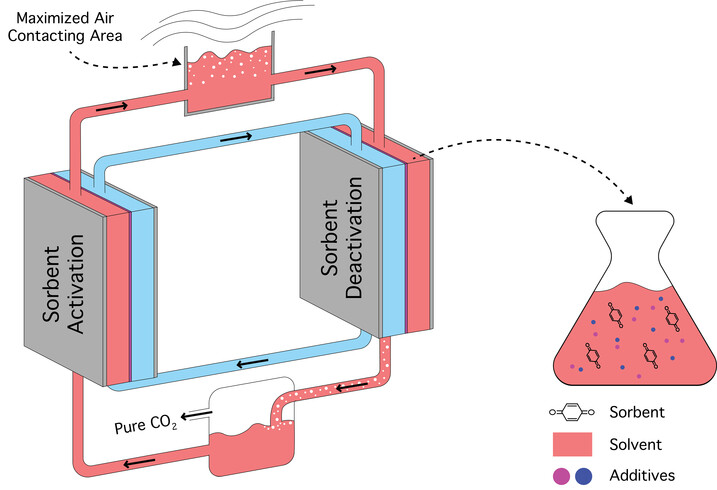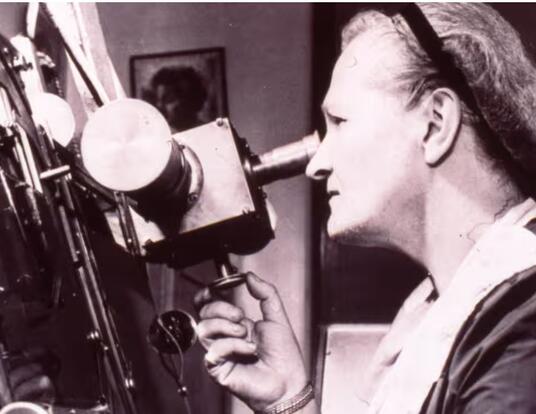Engineering a Solution to Climate Change
Cutting the cost of carbon capture to help get the world to net zero—and beyond

Research at Risk: Since World War II, universities have worked with the federal government to create an innovation ecosystem that has yielded life-changing progress. Now much of that work may be halted as funding is withdrawn. Find out more about the threats to medical, engineering, and scientific research, as well as how Harvard is fighting to preserve this work—and the University's core values.
“Humanity is on thin ice,” UN Secretary-General António Guterres said during a video message in March 2023. “And that ice is melting fast."
Guterres was responding to the AR6 Synthesis Report from the United Nations Intergovernmental Panel on Climate Change (IPCC), which warned of “a rapidly closing window of opportunity to secure a livable and sustainable future for all.” To keep temperature rise to 1.5°C and avoid a cascade of climatological catastrophes—flood, drought, famine, disease, species extinction, and many, many others—the world must cut greenhouse gas emissions in half by 2030.
If there was any encouraging information in the report it was that the world has plenty of options for mitigating climate change. One that is increasingly attracting the attention of policymakers is direct air carbon capture—a technology that removes carbon dioxide (CO2) from the atmosphere.
That’s where engineer and entrepreneur Aaron Sabin comes in.
“With modern science, we're building an understanding of how to reverse greenhouse gas emissions,” he says. “I want to bring the full weight of innovation to this effort to remove carbon from the atmosphere before it’s too late.”
A student in the MS/MBA program of Harvard Griffin GSAS, the Harvard John A. Paulson School of Engineering and Applied Sciences, and Harvard Business School, Sabin is developing direct air capture technology that is both cost-effective and scalable. With a little luck—and a few visionary investors—he says that in the next few years, he may have a practical way to pull billions of tons of carbon out of the atmosphere, helping to arrest global warming.
Effective but not Efficient
As the IPCC noted in the March report, climate change is already underway. Global temperatures are up more than 1°C above where they were in the late 19th century. Levels of CO2 in the atmosphere are greater than at any time in the last 800,000 years. As a result, the climate scientists noted, global sea levels rose an average of three times as much each year from 2006 to 2018 as they did annually from 1901 to 1971. Heatwaves, storms, and droughts have all become more extreme.
“Even if we stopped emitting CO2 today, there’s so much already in the air,” Sabin says. “It will take generations for it to be absorbed by the oceans and biosphere. So, we need to find ways to accelerate the removal of carbon dioxide.”
Even if we stopped emitting CO2 today, there’s so much already in the air. It will take generations for it to be absorbed by the oceans and biosphere. So, we need to find ways to accelerate the removal of carbon dioxide.
-Aaron Sabin
Carbon capture technologies seek to pull carbon directly out of the atmosphere, then either use it to make something useful—say, plastic—or sequester it underground to mineralize. The challenge, of course, is that CO2 is only 0.04 percent of the Earth’s air (before the industrial age, it was less than 0.03 percent) and it’s mixed in primarily with nitrogen, oxygen, and argon gas.
That said, effective direct air capture does exist. In fact, the Biden Administration included tax credits in the Inflation Reduction Act of 2022 to encourage the use of the technology. The challenge is cost and scale. Most current methods power the carbon capture process with heat—a relatively inefficient energy source—making it expensive. More efficient methods are earlier in development but once they become more mature and proven out, Sabin says they can be highly scalable. And scale is key to make a serious dent in climate change. “Realistically, the IPCC is saying that to avoid critical levels of global warming by 2050, we need to take 10 billion tons of CO2 per year out of the atmosphere,” he says. “Right now, we’re capturing about 10,000 tons per year. That’s enough to offset the emissions of about 600 US residents.”
The Science of Flow
Sabin’s work focuses on making carbon capture more energy efficient. His model flows a liquid solution into an electrochemical cell where electricity passes through and activates it. The solution is then exposed to the air where CO2 binds with it. Next, the liquid flows through a second cell, where it is deactivated, separating the CO2. Finally, the pure carbon dioxide gas is released from the system and sequestered underground while the solution cycles through the process again.
“It all flows in a circle,” Sabin says. “The electrochemical cells pass electrons to some of the molecules in the solution. The carbon in the CO2 is electrophilic—it’s drawn to the electrons in the liquid. So, when we pass it through the air contactor and the solution interacts with the atmosphere, CO2 dissolves in it and binds with the molecules that have the extra electrons. Those electrons are removed from the molecules when the solution passes through the second cell, carbon dioxide is released as gas and stored, and the process begins again.”

Sabin says this system is vastly more efficient than current methods of carbon capture, using energy primarily to run current through the cells and run air over the exposed solution. Moreover, it can be scaled up, with large plants housing many units and concentrated in areas with low population density.
So, what’s the catch?
“The solution right now is sensitive to oxygen and water, which are present in the atmosphere in much greater quantities than CO2,” Sabin says. “Sometimes oxygen, depending on the solution’s properties, will come in and steal the electrons. That’s a problem because then the carbon dioxide won’t want to bind with the molecules in the solution. Water can also come in and decompose some of those molecules.”
The challenge is to find a carbon capture “recipe” of solvent (liquid solution), sorbent (molecules that accrue and shed electrons), and electrolytic additives that can enable the mix to stay stable when exposed to the atmosphere.
“The most promising development in this space, in my opinion, was when somebody took a very common sorbent in a certain solvent and they just dropped in a little ethanol,” Sabin says. “It’s just alcohol, the most basic thing. And it completely changed the properties of the sorbent. It made it much more oxygen stable.”
1,000,000 X
Sabin says that he expects to have a “good enough” recipe for carbon capture within two years. Then he plans to create a prototype—perhaps the size of a large bedroom—to show that it works. His mentor Michael Aziz, the Gene and Tracy Sykes Professor of Materials and Energy Technologies and a faculty associate at the Harvard University Center for the Environment, says that Sabin’s model has “a better chance than most” to make direct air capture cost-efficient.
“Electrochemical approaches such as Aaron’s have the advantage of operating at ambient temperature and pressure and being driven only by a voltage swing with carbon-free electrical energy, instead of a thermal swing driven by fuel combustion,” he says. “If the winning recipe is developed over the next year or two and a techno-economic analysis demonstrates its worth, it’s likely to take several years to scale. But that’s OK. We’ll still need it!”
Electrochemical approaches such as Aaron’s have the advantage of operating at ambient temperature and pressure and being driven only by a voltage swing with carbon-free electrical energy, instead of a thermal swing driven by fuel combustion.
-Professor Michael Aziz
A winner of Harvard Business School’s Tough Tech Prize for new ventures, Sabin is already attracting interest from venture firms but says he’s looking more at grant funders so that he can focus on research and development without the pressure of generating returns for investors. “Technology like this takes time to lock in,” he says. “I think we’ll start to have revenue in about three years.”
To develop and deploy this technology, Sabin founded a company, Lasso Flow. Russ Wilcox, a partner at the investment firm Pillar VC who co-teaches the MS/MBA capstone course LaunchLab, says he looks forward to seeing his student’s firm grow.
"Aaron has been studying the field for months, and he seems inspired by a particular technical path forward that he sees,” Wilcox says. “He brings strong leadership and business skills to the table as well. It will be fun to see him build a company from here."
Sabin cautions that direct air capture isn’t a replacement for ongoing decarbonization efforts. The world still needs to cut GHG emissions as quickly as possible. But he says that his technology could not only help get to net zero but also net negative emissions, restoring “normal” CO2 levels in the decades ahead. Once his direct air capture technology is up and running, he believes that it can be brought to scale relatively quickly, helping to reduce—and perhaps reverse—the damage humanity has done to the climate.
“The beauty of electrochemistry is that the physics don't change based on the size of the operation,” he says. “You can stack these modular cells one after the other. It will take some time and money, and we still need to vastly reduce our emissions, but I do think that scaling up a million times in the next 30 years is possible.”
Get the Latest Updates
Join Our Newsletter
Subscribe to Colloquy Podcast
Simplecast





